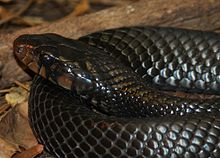Drymarchon
| Drymarchon | |
|---|---|

| |
| Drymarchon couperi, eastern indigo snake | |
| Scientific classification | |
| Domain: | Eukaryota |
| Kingdom: | Animalia |
| Phylum: | Chordata |
| Class: | Reptilia |
| Order: | Squamata |
| Suborder: | Serpentes |
| Family: | Colubridae |
| Subfamily: | Colubrinae |
| Genus: | Drymarchon Fitzinger, 1843[1] |
| Species | |
|
See text | |
| Synonyms[2] | |
| |
Drymarchon is a genus of large nonvenomous colubrid snakes, commonly known as indigo snakes or cribos,[3] found in the Southeastern United States, Central America, and South America.
Description
Indigo snakes are large, robust snakes. They have smooth dorsal scales, and several color variations, including a glossy blue-black color. This snake genus, Drymarchon, means "Lord of The Forest". The species in this genus are sexually dimorphic, with the males being larger than the females. This is thought to be due to intraspecies competition from the males.[4]
Behavior and diet
Indigo snakes are diurnal and actively forage for prey. They feed on a broad variety of small animals such as
Habitat
The current distribution of D. couperi is reported as extending from the Coastal Plain of southern Georgia to peninsular Florida and the lower Florida Keys west to Southeastern Mississippi. They use a variety of different habitats, including longleaf pine-turkey oak sandhills, pine and scrub flatwoods, dry prairie, tropical hardwoods, freshwater wetlands, and coastal dunes; however, winter survival, especially in northern portions of its range, depends on the availability of appropriate shelters which are primarily Gopher Tortoise burrows.[6] These burrows can be used to hide from predators, fires, and extreme temperatures.[7]
Threats
Populations in Alabama, Texas, and South Carolina have been largely lost due to habitat destruction, poaching, and killings. Indigo snakes are currently protected under the United States Fish and Wildlife Service and the Florida Fish and Wildlife Conservation Commission which makes it illegal to possess, harm, or harass them. Permits are also required in order to keep or transport this species.[8]
Species and subspecies

The genus Drymarchon was formerly considered to be a
- Falcon indigo snake — Drymarchon caudomaculatus Wüster, Yrausquin & Mijares-Urrutia, 2001[10]
- Indigo snake — Drymarchon corais (F. Boie, 1827)
- Gulf Coast indigo snake — Drymarchon kolpobasileus Krysko, Granatosky, Nuñez & D. J. Smith, 2016[12]
- Margarita indigo snake — Drymarchon margaritae Roze, 1959
- Middle American indigo snake — Drymarchon melanurus (A.M.C. Duméril, Bibron & A.H.A. Duméril, 1854)
- Black-tailed cribo — Drymarchon melanurus melanurus (A.M.C. Duméril, Bibron & A.H.A. Duméril, 1854)
- Orizaba indigo snake — Drymarchon melanurus orizabensis (Dugès, 1905)
- Mexican red-tailed indigo snake — Drymarchon melanurus rubidus H.M. Smith, 1941
- Unicolor cribo — Drymarchon melanurus unicolor H.M. Smith, 1941
References
- ^ Fitzinger L (1843). Systema Reptilium, Fasciculus Primus, Amblyglossae. Vienna: Braumüller & Seidel. 106 pp. + indices. (Drymarchon, new genus, p. 26). (in Latin).
- ^ McCranie, James R. 1980. Drymarchon, D. corais. Catalogue of American Amphibians and Reptiles. Society for the Study of Amphibians and Reptiles, 267: 1-4.
- ^ "Cribos and Indigo Snakes" (PDF). madisonherps.org. Archived from the original (PDF) on 2018-10-22. Retrieved 2018-10-21.
- S2CID 86306664.
- ISSN 1528-7092.
- ^ Hyslop, N.L (2007). "Movements, habitat use, and survival of the threatened eastern indigo snake (Drymarchon couperi) in Georgia". Diss. University of Georgia: 12.
- JSTOR 43188431.
- S2CID 86306664.
- ^ "Drymarchon ". Integrated Taxonomic Information System. Retrieved 2011-02-06.
- ^ Wüster, Wolfgang; Yrausquin, José Luís; Mijares-Urrutia, Abraham [in French] (2001). "A new species of indigo snake from north-western Venezuela (Serpentes: Colubridae: Drymarchon)" (PDF). Herpetological Journal. 11: 157–165. Archived from the original (PDF) on 2007-02-05. (Drymarchon caudomaculatus, new species).
- .
- PMID 27470779.
- . Retrieved 12 November 2021.
